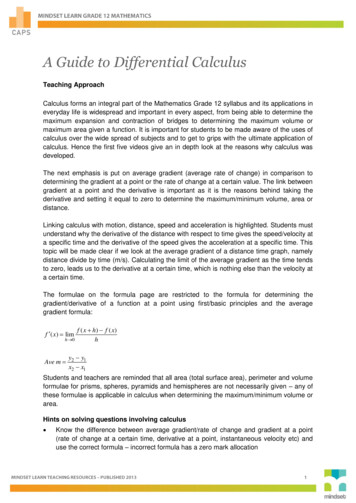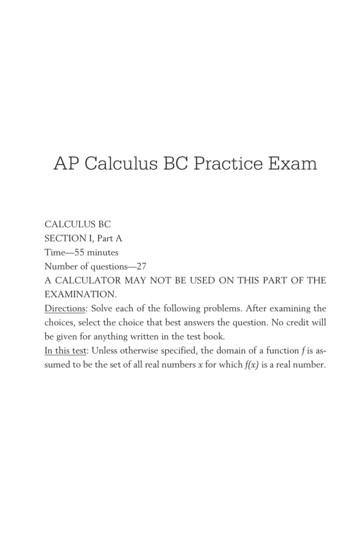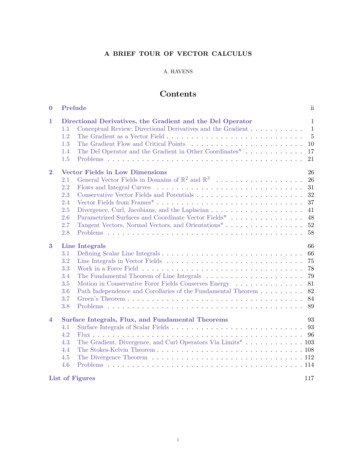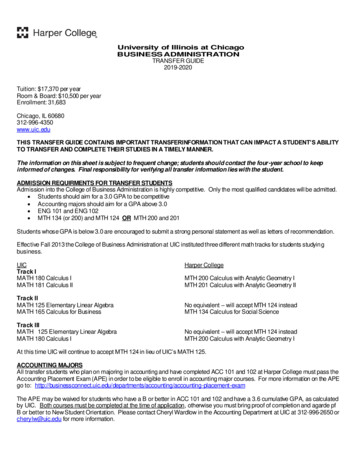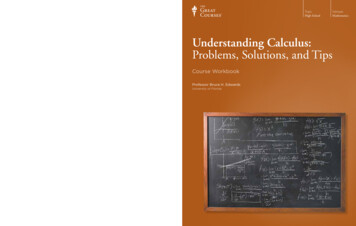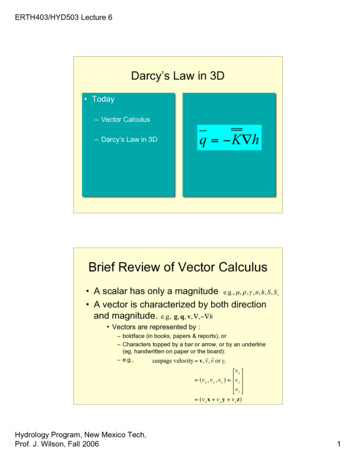
Transcription
ERTH403/HYD503 Lecture 6Darcy’s Law in 3D Today– Vector Calculus– Darcy’s Law in 3Dq " K!hBrief Review of Vector Calculus A scalar has only a magnitude e.g., µ , " , ! , n, h, S , S s A vector is characterized by both directionand magnitude. e.g, g, q, v, ",!"h Vectors are represented by :– boldface (in books, papers & reports), or– Characters topped by a bar or arrow, or by an underline(eg, handwritten on paper or the board):r– e.g.,seepage velocity v, v , v or v.&v x # ( v x , v y , v z ) v y ! !% v z "! (v x x v y y v z z)Hydrology Program, New Mexico Tech,Prof. J. Wilson, Fall 20061
ERTH403/HYD503 Lecture 6Brief Review of Vector CalculusWe’ll top a character with a bar, or use boldface, to indicate a vector.f a x b y czwhere a, b, c are all scalarszz (unit vector in the Z direction)yy (unit vector in the Y direction)xx(unit vector in the X direction)Brief Review of Vector Calculusf ax b y czzczaxfonto each axisOrthogonal projection onto each axes.zxProject vectorfbyyyxHydrology Program, New Mexico Tech,Prof. J. Wilson, Fall 20062
ERTH403/HYD503 Lecture 6Brief Review of Vector CalculusTo find the magnitude (length) of a vector:The magnitude of vector f (written f ) isf a2 b2 c2where f a x b y c zTo multiply a vector by a scalar:&ma #m f ma x mb y mc z mb !! % mc !"A vector multiplied by a scalar results in a vector.Multiplication by a scalar only affects the vector length.Brief Review of Vector CalculusMultiplying vectors by each other:For groundwater flow, the dot or inner product isthe most commonly used product.Given two vectors:gg gx x g y y gz zkk kx x k y y kz zThe dot productg ! k is a scalar:(g dot k ) is the product of the component of gin the direction ofk with magnitude kThe result is a scalar.Hydrology Program, New Mexico Tech,Prof. J. Wilson, Fall 20063
ERTH403/HYD503 Lecture 6Brief Review of Vector Calculus!g(gdotk) is the product of the component ofin the direction ofkkwith magnitudegkThe result is a scalar.This is the component ofg in the direction of k .It equals g cos(! ) .g ! k g k cos(" ) g x k x g y k y g z k z sum (products of components)Brief Review of Vector CalculusReminder from freshman Physics: pushing a carForce in the x-direction moves the car.Find and sum the x-direction forces:Force contributed isF2 cos (45 )yxF1100% of forcecontributedHydrology Program, New Mexico Tech,Prof. J. Wilson, Fall 2006F3F245 No contributionDirection of movement4
ERTH403/HYD503 Lecture 6Brief Review of Vector CalculusSpecial Cases:Orthogonal Vectors: dot product is zerogg ! k g k cos(90 o ) g k 0 0kParallel Vectors: dot product is the product of vector magnitudes:gkg ! k g k cos(0 o ) g kBrief Review of Vector CalculusGradient operator:The gradient operator is a way of doing differentiation with vectors.It is a vector operator.Gives the rate of change of a scalar fieldin the direction of the greatest rate of change.!( ) : pronounced “del”z!z!( )The ( ) indicates the vectordel is operating on a scalarz1yy1xIn this case it is !z because del isoperating on elevation z.x1Hydrology Program, New Mexico Tech,Prof. J. Wilson, Fall 20065
ERTH403/HYD503 Lecture 6Brief Review of Vector CalculusGradient operator:"( ) !( )!( )!( )x y z!x!y!zExample:h ( x, y , z ) x 2 2 y z!h ( x , y , z ) 2 x x 2 y zHydraulic gradient:The driving force for groundwater flow is -!h, where h is head,because !h points in the increasing direction.Define the hydraulic gradient vectorJ !"hBrief Review of Vector CalculusFor a one-dimensional system (a Darcy column)h varies only in x-direction, ie h(x)Gradient of h :"h ( x ) !h( x)!h( x)!h( x)!h( x)dhx y z x !x!y!z!xdxIf conductivity and area is uniform within the column (and nosources/sinks), then dh dx is linear, sodh !h !h dx !x !lHydrology Program, New Mexico Tech,Prof. J. Wilson, Fall 20066
ERTH403/HYD503 Lecture 6Brief Review of Vector CalculusDivergence:The divergence is obtained by taking the dot product of the gradientoperator and another vector, eg., specific discharge.The result is a scalar.Divergence operator:"! f"!( )is the “divergence of vectorf”It’s basically taking the partial derivative of each component of avector and then summing the result.( !( )!( )!( ) %!a !b !c)" f &x y z# " a x b y c z !y!z !x !y !z' !x()Brief Review of Vector Calculus! " [!( )]" # ["( )] Written asis the “divergence of the gradient”.! !( ) ! !( ) ! !( ) ! 2 ( ) ! 2 ( ) ! 2 ( ) !x !x !y !y !z !z!x 2!y 2!z 2!2 () and called the Laplacian Operator.It is basically taking the second partial derivative.Example. Given h h( x, y , z ) then! 2 h ( x, y , z ) ! 2 h ( x, y , z ) ! 2 h ( x, y , z )" h !x 2!y 2!z 22Hydrology Program, New Mexico Tech,Prof. J. Wilson, Fall 20067
ERTH403/HYD503 Lecture 6Brief Review of Vector CalculusIf ! 2 h 0 thenLaplace’s equationIf ! 2 h " a constant or a function of space thenPoisson’s equationThe divergence shows the presence of sources/sinksand other internal forcings.More on Tensors& K xx K K yx K zx%K xyK yyK zyK xz #!K yz !K zz !"Kij is the entry from the ith row, jth columnKij gives flux in ith -direction for a unit gradient applied in the jth-directionKis a symmetric tensor (Kij Kji)Hydrology Program, New Mexico Tech,Prof. J. Wilson, Fall 20068
ERTH403/HYD503 Lecture 6Extrapolation of Darcy’s Law to 3Dfor anisotropic, heterogeneous porous mediaq " K!horq "K#h!hqi " K ij!x j!Einsteinian notatonExtrapolation of Darcy’s Law to 3D"q x%x 'q qy y' ( #qz z '&"K xx K xy K yx K yy #K zx K zy")h K xz % )x' )hK yz ' )yK zz '& )h # )z"% '% (K )h K )h K )h ) x'x'xyxz xx )x')y)z' ')h)h)hy' ( (K yx K yy K yz ) y')x)y)z' '')h)h)h z'(K K zy K zz ) z ' zx )x'&)y)z 14444244443 'qZ#&i.e.,!Hydrology Program, New Mexico Tech,Prof. J. Wilson, Fall 2006q " K!h9
ERTH403/HYD503 Lecture 6Extrapolation of Darcy’s Law to 3D!h!h!h K xy K xz )!x!y!z!h!h!hq y "( K yx K yy K yz )!x!y!z!h!h!hq z "( K zx K zy K zz )!x!y!zq x "( K xxDarcy’s Law in 3DKmaxq " K !hKminIf our coordinate axes for our problem are aligned differently than the principal directionsof K, we must use a full tensor for KzxyHydrology Program, New Mexico Tech,Prof. J. Wilson, Fall 200610
ERTH403/HYD503 Lecture 6Instead, we can rotate coordinate axes so they are parallel to the “axes” ofthe conductivity ellipsoidzyxThen& K xx K K yx K zx%K xyK yyK zyK xz # & K xx!K yz ! 0K zz !" % 0q " K#h "( K xx0K yy00 #0 !!K zz !"(all off-diagonalcomponentsequal zero)!h!h!hx K yyy K zzz)!x!y!zDarcy’s Law in 3DSuppose K is isotropic:this implies off-diagonal terms in K are zero,and thatKxx Kyy Kzz Ki.e., flow is strictly in the direction of gradientq "K (#h#h#hx y z ) " K! h#x#y#zIf we consider flow in only one direction, say x:Hydrology Program, New Mexico Tech,Prof. J. Wilson, Fall 2006q "K!h!x11
ERTH403/HYD503 Lecture 6Darcy’s Law in 3D Review Next time– Conservation of Mass– Continuity– Field Equations– Vector Calculus– Darcy’s Law in 3DSs#h "!q !( K!h )#tGroundwater Balance Aquifer wide:PumpingChange in storage Recharge– Pumping – GW Discharge– ETGW Underflow Forcings What about the water balance withinan individual Control Volume (CV)Pumpingflowsomewhere (any arbitrary CV)within the aquifer?Hydrology Program, New Mexico Tech,Prof. J. Wilson, Fall 200612
ERTH403/HYD503 Lecture 6Continuity Equation Assumptions– 1. Medium is not deformable but undergoes elastic compressionin the vertical direction– Terzaghi assumption– 2. Fluid is only slightly compressible– density is nearly constantFrom 1 and 2 all compressibility effects are described by specificstorage, Ss, which is the only form of storage– 3. Darcy’s law applies Statement of Mass Conservation (or Continuity)– Rate of change of storage Volumetric flux in – volumetric flux out– No other sources/sinks or forcingsContinuity EquationVolumetric flux into the CV:“x ”ntstancoefacq x ,in Ax q x dydzVolumetric flux into the back y face q y ,in Ay q y dxdzVolumetric flux into the top z face q z ,in Az q z dydxVolumetric flux into the left x face Total volumetric flux in q x dydz q y dxdz q z dydxNote positive down in this derivationHydrology Program, New Mexico Tech,Prof. J. Wilson, Fall 200613
ERTH403/HYD503 Lecture 6Continuity EquationVolumetric flux out of the CV:Atd“x Volumetric flux out of the right x face ( q xx nt”stancoefac!q x)dydz!xWhere does this come from?If qx,out ! qx,in , then qx must have changed over dx.The "qx/ "x grasps this change."qxdxAx"x"q qx dydz x dxdydz"xqx,out AX qx Ax Mathematical justification: Taylor Series Approximation!Continuity EquationVolumetric flux out of the CV:“x AtVolumetric flux out of the right x face ( q xVolumetric flux out of the front y face ( q ydx nt”stancoefac!q xdx )dydz!x!q ydy )dxdz!y!qZdz )dydxVolumetric flux out of the bottom z face ( q Z !z Total volumetric flux out (qx !q y!q x!qdx )dydz ( q y dy )dxdz ( q z z dz )dxdy!x!y!zHydrology Program, New Mexico Tech,Prof. J. Wilson, Fall 200614
ERTH403/HYD503 Lecture 6Continuity EquationNet volumetric flux into the CV:Net volumetric flux into the CV volumetric flux in – volumetric flux out q x dydz q y dxdz q z dydx!q y!q!q" [( q x x dx )dydz ( q y dy )dxdz ( q z z dz )dxdy ]!x!y!z!q y!q x!qdxdydz dydxdz z dzdxdy ]!x!y!z!q y !q z!q "( x ) dxdydz!x!y!z "[ # " ! q dxdydzContinuity EquationRate of change of storage in the CV:Rate of change in storage !Vw!tBut!Vw S s VT !hwhere VTRate of change in storage S s VTHydrology Program, New Mexico Tech,Prof. J. Wilson, Fall 2006 dx dy dz!h!h Ssdx dy dz!t!t15
ERTH403/HYD503 Lecture 6Continuity Equation Statement of Mass Conservation (or Continuity)Rate of change of storage Volumetric flux in – volumetric flux outSs!hdx dy dz!t "(SsSs!q x !q y !q z ) dxdydz # " ! q dxdydz!x!y!z!q y !q z!q!h "( x )!y!x!y!z#h "!q#tor S s#h "!q 0#tContinuity Equation Statement of Mass Conservation (or Continuity)Rate of change of storage Volumetric flux in – volumetric flux outSs"h # %q"t" Ss#h K 2 h#tq "K#h!!!()"# q "# "K#h K# 2 hIf hydraulic conductivity is isotropic:" Ss#h K 2 h#t!!Hydrology Program, New Mexico Tech,Prof. J. Wilson, Fall 200616
ERTH403/HYD503 Lecture 6Vertically Integrated Aquifer EquationAquifer equation,for homogeneous K:Multiply by thickness,to “upscale”K" 2 h S Sb!h!th(x,y,z,t)!h!t!hT" 2 h S!tKb" 2 h S S bDefine T and S!h"2h ST !tRewrite ash(x,y,t)a “diffusion equation”Another homology to heat conduction or solute diffusionSTan upscaled hydraulic diffusivityDarcy’s Law in 3D Review Next time– Boundary Conditions– Initial Conditions– Proper MathematicalStatement – Conservation of Mass– Continuity– Field EquationsHydrology Program, New Mexico Tech,Prof. J. Wilson, Fall 2006Ss#h "!q !( K!h )#t17
ÐVector Calculus ÐDarcyÕs Law in 3D q "K!h Brief Review of Vector Calculus A scalar has only a magnitude A vector is characterized by both direction and magnitude. Vectors are represented by : Ðboldface (in books, papers & reports), or ÐCharacters topped by a bar or arrow, or by an underline (eg, handwritten on paper or the board .

